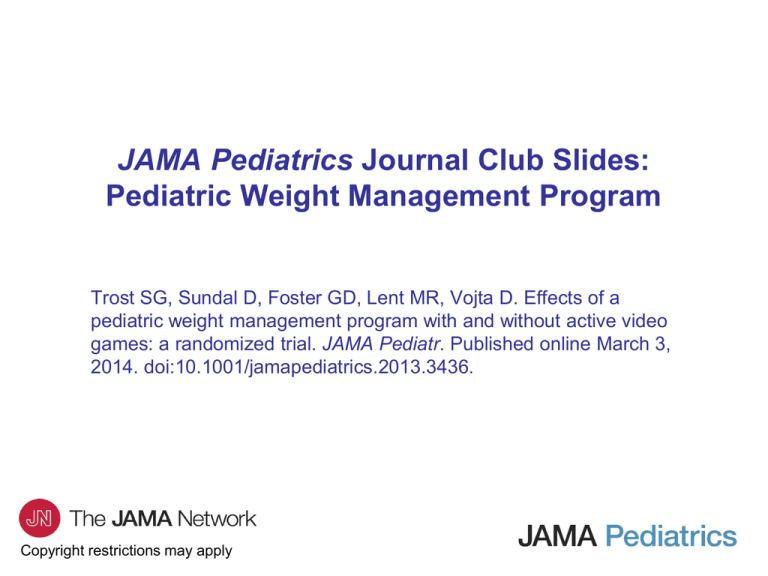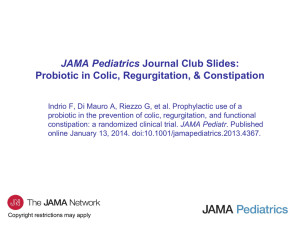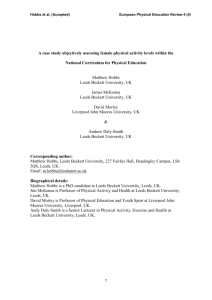
JAMA Pediatrics Journal Club Slides:
Pediatric Weight Management Program
Trost SG, Sundal D, Foster GD, Lent MR, Vojta D. Effects of a
pediatric weight management program with and without active video
games: a randomized trial. JAMA Pediatr. Published online March 3,
2014. doi:10.1001/jamapediatrics.2013.3436.
Copyright restrictions may apply
Introduction
•
Background
– Physical inactivity is an important contributing factor to the
development and maintenance of childhood obesity.
– Active video games may be an effective strategy to increase physical
activity in overweight and obese children.
– The specific effects of active gaming on physical activity and weight
loss delivered within the context of a pediatric weight management
program are unknown.
•
Study Objective
– To evaluate the effects of active video gaming on physical activity and
weight loss in children participating in an evidence-based weight
management program delivered in the community.
Copyright restrictions may apply
Methods
•
Study Design
– Group-randomized trial conducted during a 16-week period.
•
Setting
– YMCAs and schools located in Massachusetts, Rhode Island, and Texas.
•
Patients
– 75 overweight or obese children (41 girls [55%], 34 whites [45%], 20
Hispanics [27%], and 17 blacks [23%]) enrolled in a community-based
pediatric weight management program.
– Mean (SD) age, 10.0 (1.7) years.
– Mean (SD) body mass index (BMI) z score, 2.15 (0.40).
– Mean (SD) percentage overweight, 64.3% (19.9%).
Copyright restrictions may apply
Methods
Copyright restrictions may apply
Methods
Descriptive Characteristics for the Total Sample and the Treatment Groups at Baselinea
Copyright restrictions may apply
Methods
•
Outcomes
– Measured at baseline, week 8, and week 16 of the program.
– Physical activity was measured using the ActiGraph GT3X or GT3X+
accelerometer-based motion sensor.
– Daily time spent in moderate-to-vigorous physical activity (MVPA) and
vigorous physical activity (VPA).
– Percentage overweight calculated as the percentage over the median BMI
for age and sex.
– BMI z score using the 2000 BMI-for-age growth charts from the Centers
for Disease Control and Prevention.
Copyright restrictions may apply
Methods
•
Limitations
– Program conducted over 16 weeks. Whether positive changes are
maintained remains a question for future research.
– The costs associated with the purchase of game consoles and individual
games may be a barrier for low-income families.
Copyright restrictions may apply
Methods
•
Intervention
– All participants received a comprehensive family-based pediatric weight
management program (JOIN for ME).
– Participants in the program and active gaming condition received a
game console and motion capture device (Xbox and Kinect; Microsoft
Corp) and 1 active sports game at their second treatment session and
received a second active game halfway through the program.
– Participants in the program-only condition were given an Xbox, Kinect,
and 2 games at the completion of the 16-week program.
Copyright restrictions may apply
Results
•
Program and active gaming participants exhibited significant increases in
MVPA (mean [SD], 7.4 [2.7] min/d) and VPA (2.8 [0.9] min/d) at week 16
(P < .05).
•
MVPA and VPA declined or remained unchanged in participants in the
program-only control group.
•
MVPA mean (SD) net difference = 8.0 (3.8) min/d (P = .04).
•
VPA mean (SD) net difference = 3.1 (1.3) min/d (P = .02).
•
Participants in both conditions exhibited significant reductions in percentage
overweight and BMI z score at week 16.
•
Program and active gaming participants exhibited significantly greater
reductions in percentage overweight (mean [SD], −10.9% [1.6%] vs −5.5%
[1.5%]; P = .02) and BMI z score (−0.25 [0.03] vs −0.11 [0.03]; P = .001).
Copyright restrictions may apply
Results
Copyright restrictions may apply
Results
Copyright restrictions may apply
Results
Copyright restrictions may apply
Results
Copyright restrictions may apply
Comment
•
First study to use a randomized controlled trial study design to delineate the
effects of active gaming on habitual physical activity among obese children.
•
The addition of active gaming to an established community-based pediatric
weight management program resulted in significant increases in MVPA
among obese children.
•
Consistent with the results of a previous evaluation of the JOIN for ME
pediatric weight loss program, all participants, regardless of study
allocation, exhibited significant and clinically meaningful reductions in
relative weight.
•
Providing participants an active gaming console and a game resulted in a
50% greater reduction in relative weight and BMI z score.
Copyright restrictions may apply
Comment
•
The study used a state-of-the-art objective measure of physical activity, thus
eliminating the substantial recall bias and measurement error associated
with self-report methods.
•
The study examined the impact of active gaming in the context of a fully
scalable, community-based pediatric weight management program
administered in schools and YMCAs. Thus, the potential for translating
these findings to other settings and population groups is high.
Copyright restrictions may apply
Contact Information
•
If you have questions, please contact the corresponding author:
– Stewart G. Trost, PhD, Center for Research on Exercise, Physical
Activity and Health, School of Human Movement Studies, The
University of Queensland, Brisbane, QLD, Australia 4072
(s.trost@uq.edu.au).
Funding/Support
•
This study was supported by the UnitedHealth Group.
Conflict of Interest Disclosures
•
Dr Trost is a member of the ActiGraph Scientific Advisory Board. Dr Foster
serves as a consultant to the UnitedHealth Group. Ms Sundal and Dr Vojta
are employees of UnitedHealth Group. No other disclosures are reported.
Copyright restrictions may apply












